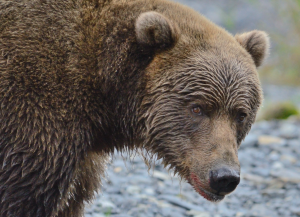Bears exhibit two notable springtime behaviors. The first is emergence from their dens, and the second is courtship and mating. In this post, I will discuss hibernation and den emergence of brown bears on Kodiak Island, and I will cover courtship and mating in a later post.
Normally, you don’t see a bear leave his den. All you see is a hole in the snow high on the mountainside with dirt trailing out of the hole and tracks leading away from it. Occasionally, you might be lucky enough to observe a head sticking out of a den entrance, or you may see a bear sitting right in front of or next to the den entrance. Sometimes, you see the bear disappear back into the den and then reappear later. This is often the behavior of a sow with newborn cubs, as the mother slowly acclimates the cubs to the world outside the den.
While I don’t plan to cover bear hibernation in detail in this post, I must mention that when bears hibernate, they do not experience the extreme dormancy that many rodents do. While most bears spend the winter in hibernation, they can and do go in and out of hibernation, and on Kodiak where winters are relatively mild, some bears (mostly older males) do not hibernate at all. It is common to see bear tracks all winter on Kodiak.
There are very few natural rock caves on Kodiak, so bears dig their dens either into the side of a mountain or the side of a snow bank. Research on Kodiak has shown that bears on the north end of the island usually dig their dens at a high elevation, where the soil remains frozen all winter, and the den remains stable. On the south end of the island where the mountains are not as high, bears tend to dig dens in mid-slope habitat in alder thickets, where the dens are stabilized by alder roots.
Pregnant females are usually the first to enter their dens, followed by lone females and females with cubs. Males normally are the last to enter their dens. The time of den emergence in the spring is dependent on temperature and weather conditions, but males typically leave their dens first, followed by single females and sows with cubs. Sows with newborn cubs are the last to emerge. Males on Kodiak spend an average of three to five months in hibernation, while pregnant females may hibernate as long as seven months.
Pregnant sows give birth while in hibernation; which is an amazing feat of nature, since the sow must provide nutrients to her unborn young while she is hibernating and not eating. She provides these nutrients by breaking down her own body proteins, and this causes her to lose muscle mass. Since she would not be able to move if she lost too much muscle mass, a sow gives birth to very under-developed cubs. No other mammals except marsupials have such immature offspring at birth. A newborn cub weighs one pound (.5 kg). They are blind, deaf, and unable to smell. They are covered by a very fine hair and are toothless, weak, and uncoordinated. They can detect temperature changes, so they move closer to their mother to seek warmth, and they are also able to find the sow’s nipples to nurse. A bear’s milk is very rich, and cubs gain weight quickly, but they are still small and fragile by the time they leave the den, and their mother is very protective of them.
During hibernation, bears do not eat, urinate, or defecate. When they leave their dens in the spring, they are groggy and sluggish, and it takes time for their bodily functions to return to normal. Soon after leaving their dens, bears often pass a fecal plug that may be as long as two feet (61 cm) in length. This plug consists of digested food that has accumulated in the lower intestine as a result of not defecating all winter.
After bears leave their dens, they drink large amounts of water but eat very little, concentrating on emerging plants and roots. As spring progresses, they begin grazing on sedges and grasses as well as other plants, and by summer, they are voracious eaters, consuming protein-rich salmon and berries loaded with sugar. By late summer and fall, a bear may consume 20,000 calories per day and add six to eight inches (15.24 to 20.32 cm) of fat to his body as he prepares for his next hibernation.













